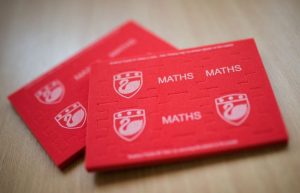Maths at Paulet

What do students learn in Maths in Key Stage 3?
In KS3, students learn a variety of topics including Algebra, Number, Shape and Mathematical Reasoning
Students
- become fluent in the fundamentals of mathematics, including through varied and frequent practice with increasingly complex problems over time, so that students develop conceptual understanding and the ability to recall and apply knowledge rapidly and accurately
- reason mathematically by following a line of enquiry, conjecturing relationships and generalisations and developing an argument, justification or proof using mathematical language
- can solve problems by applying their mathematics to a variety of routine and non-routine problems with increasing sophistication, including breaking down problems into a series of simpler steps and persevering in seeking solutions.
The programme of study for Key Stage 3 is organised into distinct units that build on students’ Key Stage 2 knowledge. Students are encouraged to make connections across mathematical ideas to develop fluency, mathematical reasoning and competence in solving increasingly sophisticated problems.
How do students learn in KS3 Maths?
In KS3 maths we follow the White Rose Scheme of Work. This focuses on algebra and number skills for the first year in secondary school and then moves onto shape, probability and the other elements of maths. Worksheets and textbooks are widely used as well as other resources that provide appropriate challenge and scaffold to those students that require.
What topics are covered and when in each year group? What is the sequence of teaching?
| Year 7 | Autumn | Spring | Summer | |
| Topics | Sequences | Solving problems with addition and subtraction | Constructing, measuring and using geometric notation | |
| Understand and use algebraic notation | Solving problems with multiplication and division | Developing geometric reasoning | ||
| Equality and equivalence | Fractions and percentages of amounts | Developing number sense | ||
| Place value and ordering integers and decimals | Operations and equations with directed number | Sets and probability | ||
| Fraction, decimal and percentage equivalence | Addition and subtraction of fractions | Prime numbers and proof | ||
| Year 8 | Autumn | Spring | Summer | |
| Topic | Ratio and scale | Brackets, equations and inequalities | Angles in parallel lines and polygons | |
| Multiplicative change | Sequences | Area of trapezia and circles | ||
| Multiplying and dividing fractions | Indices | Line symmetry and reflection | ||
| Working in the cartesian plane | Fractions and percentages | The data handling cycle | ||
| Representing data | Standard index form | Measures of location | ||
| Tables and probability | Number sense | |||
| Year 9 | Autumn | Spring | Summer | |
| Topic | Straight line graphs | Numbers | Enlargement and similarity | |
| Forming and solving equations | Using percentages | Solving ratio and proportion problems | ||
| Testing Conjectures | Maths and money | Rates | ||
| 3D shapes | Deduction | Probability | ||
| Constructions and congruency | Rotation and translation | Algebraic representation | ||
| Pythagoras’ Theorem | ||||
How are students assessed in KS3 Maths?
Students are offered feedback in all lessons and after every assessment point. Exit tickets are used frequently during lessons to ensure small steps are understood before moving onto new content.
Each term students are assessed with a common assessment and this information informs next steps.
Home Learning
Home Learning is issued on Sparx where all students have an account linked to their school emails. This is live all year and any feedback is given immediately to help students improve. Students must log in using the blue log in with Microsoft button.
